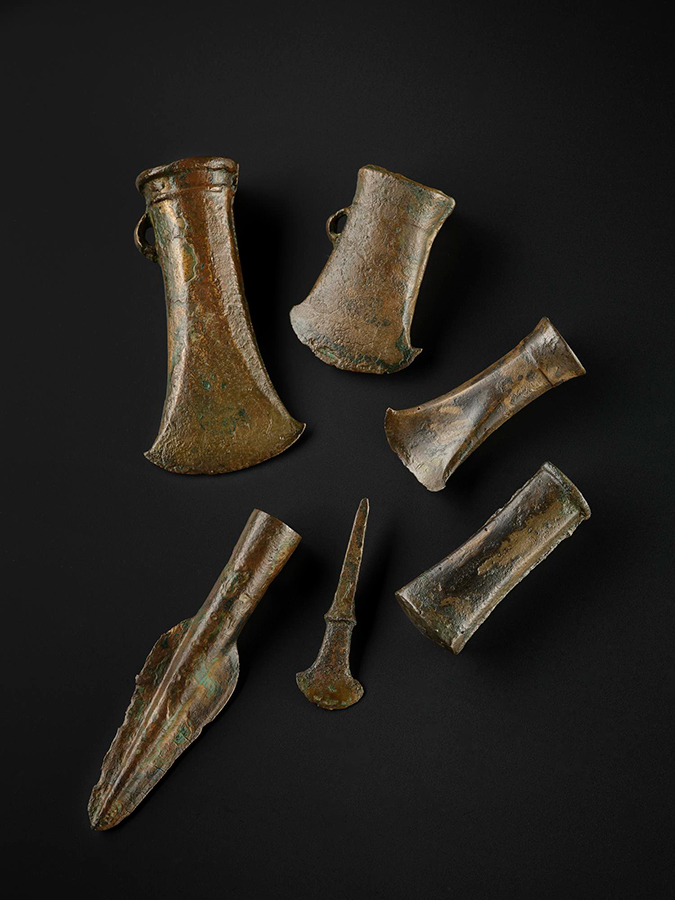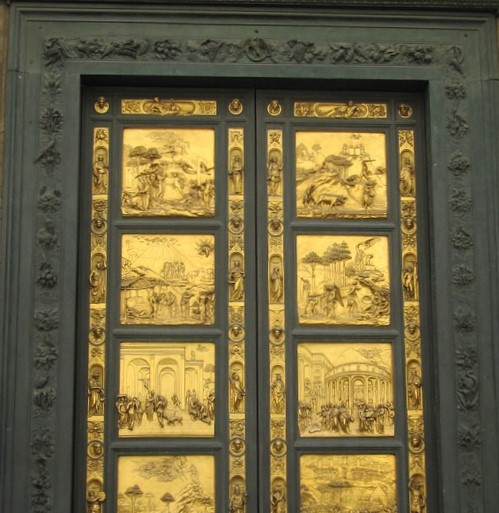Bronze
|
These late Bronze Age tools date from approximately 1000 to 800 BCE. They were found at Adabroc, Isle of Lewis in Scotland. |
Contents |
[edit] Introduction
Alloys are impure substances (admixtures) comprising a mixture of metals - or a metal to which small additions of other metals and non-metals - have been added to give it specific desired properties. The result is a compound that is likely to be superior in performance to the pure metal and may be more economical in use.
Creating an alloy may produce enhanced tensile strength, ductility, malleability, corrosion resistance and so on. The resulting alloy may retain many of the properties of the original metal, such as electrical conductivity, in addition to the new properties.
[edit] The composition of bronze
Bronze is an alloy made from a mixture of copper and tin. It is one of the best known and oldest copper alloys.
Modifications to the proportions of copper and tin can result in types of bronze with different characteristics. In some instances, lead, zinc, manganese, aluminium, nickel and other materials may be added to enhance the hardness and flexibility of bronze alloys.
Unlike brass, which is a copper alloy that always contains some form of zinc, bronze only sometimes contains zinc.
[edit] History
The discovery of bronze dates to the Bronze Age - a period of history where humans moved away from working solely with stone to produce objects such as weapons and tools. While the precise dates of the Bronze Age vary in different parts of the world, evidence in the UK indicates the start as roughly 2500 BCE. This corresponds to dates associated with the introduction of metalworking as a skill.
The use of metals was not entirely unknown prior to the Bronze Age, but metal objects from earlier periods were usually made from a single type of metal. These objects were not particularly well suited for tasks that required durability.
During the Bronze Age, the discovery of the smelting process allowed humans to combine copper and tin to produce bronze - a much harder metal alloy. The durability of the substance has been reflected in the numerous bronze artefacts of the period that have survived.
It was during the Bronze Age that burial mounds or ‘round barrows’ became more common. These personal graves sometimes included objects made of bronze.
The mining of copper and the acquisition of tin resulted in the development of noteworthy bronze metalworking skills that produced fine tools and other durable implements. Where these skills progressed, farming based cultures increasingly began to rely on hunting based activities to supplement their food supplies. This resulted in the increased production of a wide range of weapons and tools such as axes, knives, spears and daggers, as well as ornamental items such as rings, beads, pins and bracelets.
The Bronze Age is believed to have lasted in the UK until roughly 700 BCE, which marked the beginning of the Iron Age. While iron was considered a stronger material in most circumstances, bronze was still preferred in applications where corrosion resistance was a priority. This was particularly true in instances where moisture - such the combinations of salt water and maritime objects or rainwater and public statuary - would be an ongoing concern.
[edit] Bronze in the modern age
The popularity of bronze has continued through the centuries. It is regularly used to cast sculptures and is often incorporated into doorways, columns, commemorative plaques and other decorative components.
|
These gilded bronze doors in Florence were designed by the sculptor Lorenzo Ghiberti for the north entrance of the Baptistery of San Giovanni in Florence. |
Its durability and corrosion resistant qualities also make bronze a common material in the production of hardware, springs, furniture trim, coins and so on. Bronze demonstrates high levels of thermal and electrical conductivity while being non-magnetic, which makes it suitable for use as tools (such as hammers, mallets, axes, and wrenches) in situations where the creation of sparks could be a safety issue.
[edit] Working with bronze
Bronze can be very hard to work by hand and is frequently used as a cast metal because its melting point is so low. When molten, bronze has great fluidity, so that even the most complicated details can be reproduced. Its contraction upon cooling is very slight, so there is little distortion.
When cold, the cutting edges of bronze can be tempered by hammering, which sharpens and strengthens it. It is often finished by hand. The value of antique bronze objects is often influenced by the quality of this type of hand work.
Bronze ages, acquiring a patina that can add shadows and textures. Skilled bronze workers can also achieve this effect deliberately through a process called patination.
When cleaning bronze, it is inadvisable to remove the patina unless absolutely necessary. Strong cleaners or excessively bright polishes should be avoided.
Despite its durability, bronze can corrode over time, particularly if it is exposed to high levels of air pollution. The patina eventually forms the familiar pale green copper carbonate which can partially prevent additional corrosion.

|
Bronze can also be damaged due to excessive human contact, flaws in the casting process or cracks caused by extreme weather or inhospitable climates.
[edit] Related articles on Designing Buildings
Featured articles and news
Government consultations for the summer of 2025
A year of Labour, past and present consultations on the environment, the built environment, training and tax.
CMA competitiveness probe of major housing developers
100 million affordable housing contributions committed with further consultation published.
Homes England supports Greencore Homes
42 new build affordable sustainable homes in Oxfordshire.
Zero carbon social housing: unlocking brownfield potential
Seven ZEDpod strategies for brownfield housing success.
CIOB report; a blueprint for SDGs and the built environment
Pairing the Sustainable Development Goals with projects.
Types, tests, standards and fires relating to external cladding
Brief descriptions with an extensive list of fires for review.
Latest Build UK Building Safety Regime explainer published
Key elements in one short, now updated document.
UKGBC launch the UK Climate Resilience Roadmap
First guidance of its kind on direct climate impacts for the built environment and how it can adapt.
CLC Health, Safety and Wellbeing Strategy 2025
Launched by the Minister for Industry to look at fatalities on site, improving mental health and other issues.
One of the most impressive Victorian architects. Book review.
Common Assessment Standard now with building safety
New CAS update now includes mandatory building safety questions.
RTPI leader to become new CIOB Chief Executive Officer
Dr Victoria Hills MRTPI, FICE to take over after Caroline Gumble’s departure.
Social and affordable housing, a long term plan for delivery
The “Delivering a Decade of Renewal for Social and Affordable Housing” strategy sets out future path.
A change to adoptive architecture
Effects of global weather warming on architectural detailing, material choice and human interaction.
The proposed publicly owned and backed subsidiary of Homes England, to facilitate new homes.
How big is the problem and what can we do to mitigate the effects?
Overheating guidance and tools for building designers
A number of cool guides to help with the heat.
The UK's Modern Industrial Strategy: A 10 year plan
Previous consultation criticism, current key elements and general support with some persisting reservations.
Building Safety Regulator reforms
New roles, new staff and a new fast track service pave the way for a single construction regulator.


























